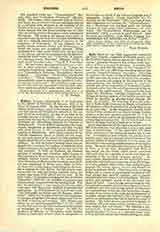

Kells, BOOK OF,—an Irish manuscript containing the Four Gospels, a fragment of Hebrew names, and the Eusebian canons, known also as the “Book of Columba”, probably because it was written in the monastery of Iona in honor of the saint. It is likely that it is to this book that the entry in the “Annals of Ulster” under the year 1006 refers, recording that in that year the “Gospel of Columba” was stolen. According to tradition, the book is a relic of the time of Columba (d. 597) and even the work of his hands, but, on palaeographic grounds and judging by the character of the ornamentation, this tradition cannot be sustained, and the date of the composition of the book can hardly be placed earlier than the end of the seventh or the beginning of the eighth century. This must be the book which the Welshman, Giraldus Cambrensis, saw at Kildare in the last quarter of the twelfth century and which he describes in glowing terms (Topogr. Hibern., II, xxxviii). We next hear of it at the cathedral of Kells (Irish Cenannus) in Meath, a foundation of Columba’s, where it remained for a long time, or until the year 1541. In the seventeenth century Archbishop Ussher presented it to Trinity College, Dublin, where it is the most precious manuscript (A. I. 6) in the college library and by far the choicest relic of Irish art that has been preserved. In it is to be found every variety of design typical of Irish art at its best.
Some small portions at the beginning and end of the MS. have been lost, but otherwise it is in a very good state of preservation. It was apparently left unfinished, since some of the ornaments remain only in out-line. It is written in part in black, red, purple, or yellow ink, and it has been thought that the hands of two scribes, neither of whom is known to us by name, are discernible in the writing and illumination of the manuscript. The most characteristic ornaments of the Book of Kells, as of the other illuminated Irish MSS. of the period, are the closely coiled spirals connected with each other by a number of curves and often terminating in the so-called “trumpet pattern”. Almost equally characteristic are the zoomorphic interlacements, colored representations of fanciful beings, or of men, animals, birds, horses, dogs, and grotesque, gargoyle-like human figures, twisted and hooked together in intricate detail. Other frequently occurring designs are a system of geometrical weavings of ribbons plaited and knotted together, and a simpler ornamentation by means of red dotted lines. The versatility and inventive genius of the illustrator surpasses all belief. Lines diverge and converge in endless succession, and the most intricate figures, in lavish abundance and with astounding variety of ornament, are combined and woven into one harmonious design. In spite of the extent of the work and its thousands of exquisite initials and terminals, there is not a single pattern or combination that can be said to be a copy of another. The artist shows a wonderful technique in designing and combining various emblems, the cross, vine, dragon, fish, and serpent. The drawing is perfection itself. It has been examined under a powerful magnifying glass for hours at a time and found to be, even in the most minute and complicated figures, without a single false or irregular line. Some of the most accomplished of modern draughtsmen have attempted to copy its elaborate designs, but, such is the delicacy of the execution, that they had to abandon the task as hopeless. In a space of one inch square were counted no less than 158 interlacings of white ribbon with a black border on either side. On the other hand, the pictures of the personages delineated are feeble and primitive and show but a limited knowledge of the human figure and its relative proportions.
No words can describe the beauty and the extreme splendor of the richly colored initial letters, which are more profuse in the “Book of Kells” than in any other manuscript. The only thing to which they can be compared is a bed of many colored crocuses and tulips or the very finest stained glass window, which they equal in beauty of coloring and rival in delicacy of ornament and drawing. The artist possessed a wonderful knowledge of the proportion of color and the distribution of his material—sienna, purple, lilac, red, pink, green, blue, yellow, the colors most often used—and he managed the shading and tinting of the letters with consummate taste and skill. (On the pigments employed by the illuminator, see Hartley in “Proceed. Royal Dublin Society, Science”, N. S., IV, 1885, p. 485.) It is remarkable that there is no trace of the use of silver or gold on the vellum. Sometimes the colors are laid on in thick layers to give the appearance of enamel, and are here and there as bright and soft and lustrous as when put on fresh more than twelve hundred years ago. Even the best photographic and color reproductions give but a faint idea of the beauty of the original. Especially worthy of notice is the series of illuminated miniatures, including pictorial representations of the Evangelists and their symbols, the Blessed Virgin and the Divine Child, the temptation of Jesus, and Jesus seized by the Jews. These pictures reach their culminating point in what is, in some respects, the most marvelous example of workmanship that the world has ever produced, namely the full-page monogram XPI which occurs in the text of the Gospel of St. Matthew. It is no wonder that it was for a long time believed that the “Book of Kells” could have been written only by angels.
JOSEPH DUNN

